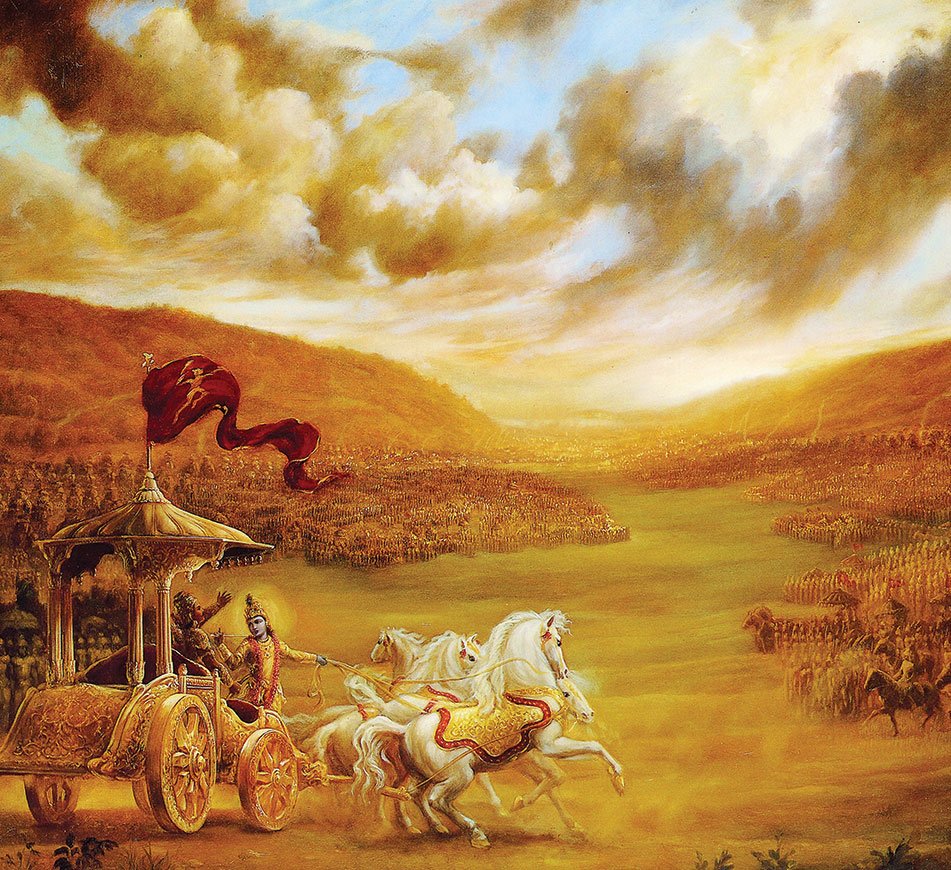What is the Bhagavad-gita?
In the epic masterpiece, Mahabharata, the longest poem in the world, the history of ancient India is documented. The story, full of twists and turns, romance and tragedy, philosophy and poetry, reaches its climax at the onset of a devastating war between a family in feud.
Over 5000 years ago, innumerable troops had converged on Kurukshetra (90 miles north of present-day Delhi) for what was billed as the greatest battle ever. Through a series of intrigues and conspiracies, the evil-minded Kauravas had usurped the throne of the Pandavas. Though born in the same clan, the Kauravas (sons of Dhritarastra) and the Pandavas (sons of Pandu) were at polar opposites. The former were plagued by greed, selfishness and pride, whereas the saintly Pandavas were individuals of the highest moral stature, dedicated to virtue, devotion and righteousness. Though grossly exploited and mistreated, the Pandavas repeatedly sought amicable means to redress the injustice, but the stubborn and greedy Kauravas were unwilling to budge an inch. Military battle and a trial of arms was inevitable.
Arjuna, the talented and dynamic Pandava archer who carried a heavyweight burden of expectation, readied himself for face-off. As tumultuous battle cries pervaded the air, the distinguished warrior suddenly experienced a moment of doubt. He requested Krishna, the Supreme Person who had assumed the position of a humble driver, to steer his chariot to the middle of the battlefield. There, Arjuna registered the reality before him – the imminent suffering and death that would consume his family, friends, fellow countrymen and soldiers who had assembled on that battlefield.
This triggered an existential confusion! In desperation, Arjuna began asking questions he had never raised before. These were the ‘big’ questions, inquiries pertaining to the happiness we all so much seek. These are the questions which linger deep within us all, but remain unaddressed in most people’s lifetime. A penetrating conversation with Krishna ensued, gems of invaluable wisdom surfaced, and the Bhagavad-gita (“song of God”) was born.
The Gita was spoken to comfort, coach and convince Arjuna in his moment of weakness. Krishna’s purpose, however, was much broader. On our own ‘battlefield of life’ we’ll all encounter moments of confusion which prompt us to venture beyond the routine treadmill of life. The Bhagavad-gita presents timeless answers to those perennial questions, offering an opportunity to upgrade our life on every conceivable level. Ancient wisdom, eternally relevant.
5 Topics of the Gita
1. Who Am I? Soul (atma)
The world is a cosmic university, wired to make us think – “is there a deeper meaning to life?” Here we come to experience and enjoy life through material pursuits.
2. Where am I? Material World (prakrti)
Our physical body is nothing more than a costume. We are spirit souls; the consciousness which animates the body. This life is merely one chapter of a much longer story.
3. What am I doing here? Activities (karma)
The law of action and reaction is nature’s way to educate and evolve us. Good actions are rewarded, bad actions are punished and spiritual actions bring real happiness and ultimate freedom.
4. How long am I here? Time (kala)
Our life, the universe and everything around us moves according to the wheel of time. Time brings death – an uncomfortable reality. We naturally seek eternity, since our real self is spiritual.
5. Is there something beyond? God (isvara)
Our ‘human journey’ is an opportunity to reawaken our eternal relationship with God and return to the spiritual world, where every step is a dance and every word a song. Krishna explains how to do this through yoga, which literally means ‘to link.’
In conclusion: As souls living in the material world, we are performing activities within the jurisdiction of time, though we actually belong in the spiritual world with God.







